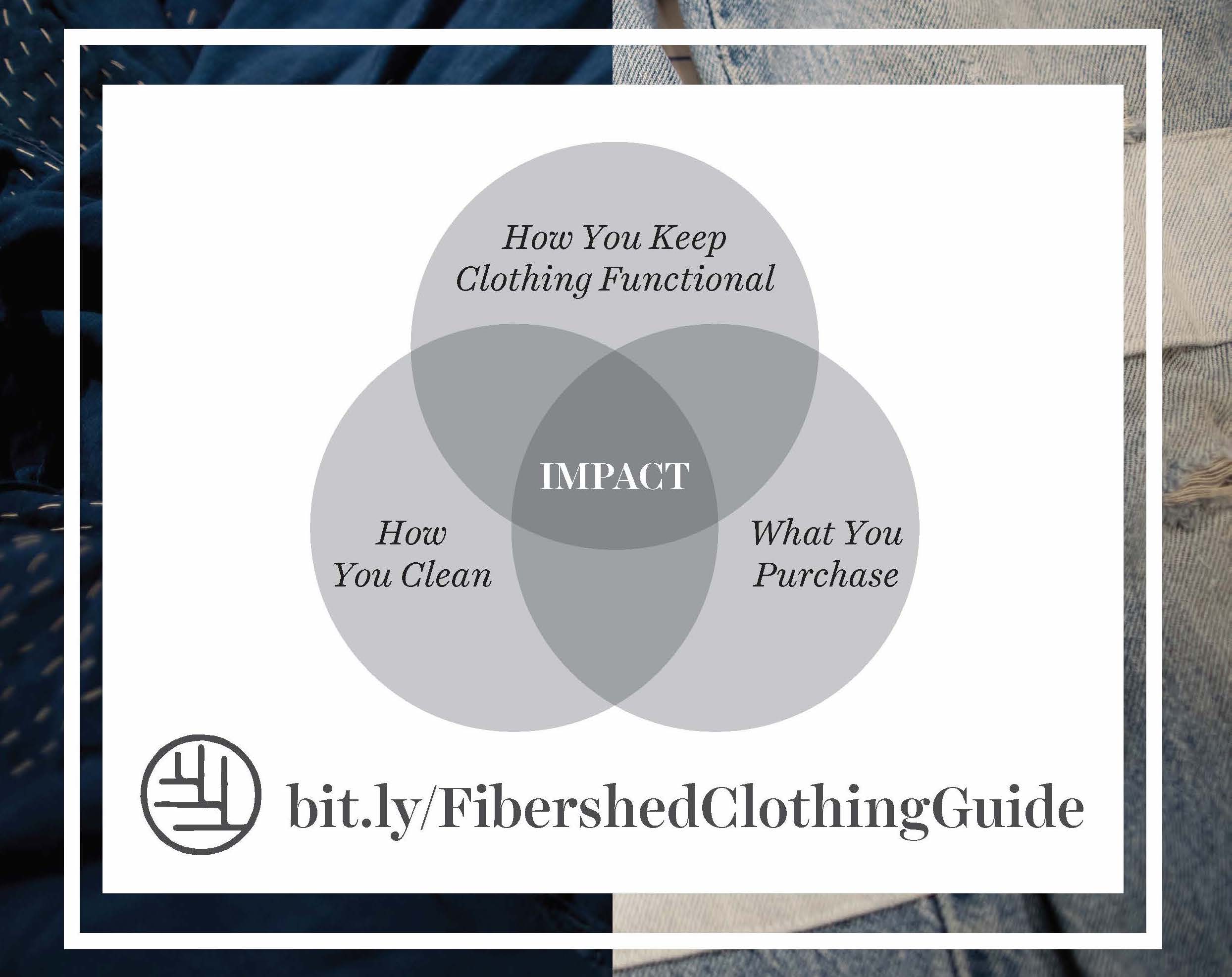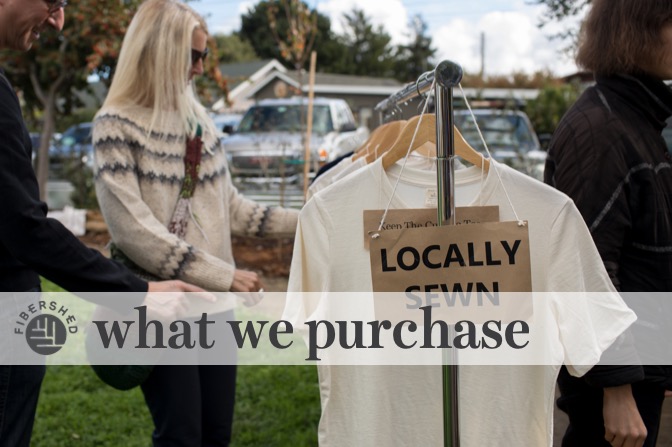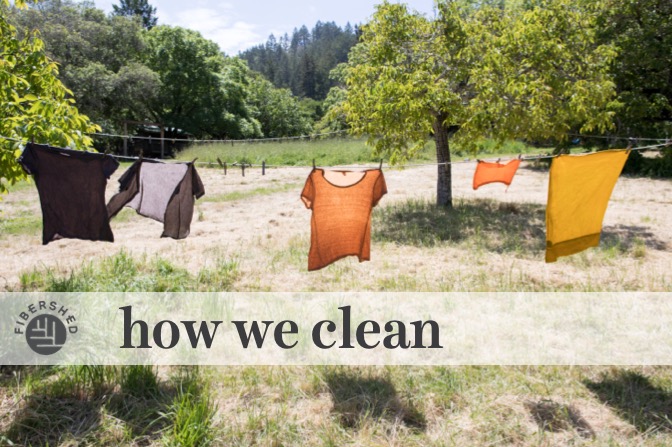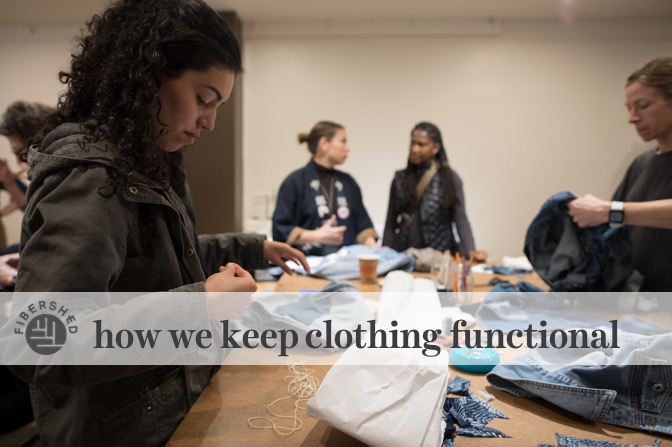Photography by Paige Green and infographics created by Fibershed
The latest large-scale assessment of the systems and supply chains that get us dressed reveals that the fashion industry’s sustainability efforts have “slowed by a third in the past year” and overall are “not moving fast enough to counterbalance the harmful impact of the fashion industry’s rapid growth.” Despite a sense of sustainable fashion as a growing movement, it appears that the pulse of actual progress, is weakening.
If you’re not at the helm of a fashion company, it can be difficult to discern exactly how our individual actions are part of achieving progress and ameliorating the impacts of our second skin. In the Fibershed Clothing Guide, we share how the impact a garment is defined by three key elements:

For suggested practices and inspiring perspectives on choosing clothing, caring for it, and keeping it in functional use, we looked to leading designers, researchers, artists, and strategists who have shared their wisdom and work with the Fibershed community. These notes from our community can help us hone our skills and shift our patterns of consumption and care.

“Think about where you put your money, and what the word “value” really means. Reality means most of us will shop at big-box stores once in a while (or even most of the time), but find ways to invest in products with a story, that last and support the fair livelihood of craftspeople who care about the products they make and the impact those products have on the earth. Understand the difference between “natural” (a hollow word that can mean anything) and “regenerative” — and choose to put what money you can toward soil-to-soil products. Make the effort to look for them, because they’re usually not sexy or flashy” – Nikki Silvestri, strategist and founder of Soil and Shadow, reflecting on Designing the Future on Medium.
“When buying new… ask yourself the things like “do I need this?”, “will this product last me a long time?”. It’s a balance and somewhat of a dance, because you want to support companies or brands or makers that are doing really great things and are making strides in the industry, but you also don’t want to use that as an excuse to buy, say, 5 hats that you don’t need that are going to sit around… A lot of this consumer need is driven by insecurity – I was guilty of it in my late teens early twenties too. At a young age I had a limited income and would opt for fast fashion chains to get my fashion fix, until I discovered second-hand and vintage clothing.” – Andrea Plell founder of Ecologique Fashion, on Building the Fashion Revolution.
And in terms of how our shopping dollars can shift economic structures, Stephany Wilkes reflected on how the Fibershed Marketplace is a unique model of producer-owned enterprise, on the first episode of the Soil to Soil podcast:
“Agricultural cooperatives are not new, but maybe new to fashion… There’s this acknowledgement, pretty openly, that we just cannot have infinite growth with finite resources, and that that is not even necessary or desirable. So it’s new and it’s interesting to see businesses embracing this idea of small is beautiful, this economy built around the needs of a community, instead of an entire country or instead of corporations… And it’s not just that these businesses are built around the needs of the community, it’s also community ownership. We don’t need to go back to the same tired, exploitative models of the past, and I would say of the present, of course — which is a few people getting rich while the majority of workers and their families and the people those workers would support are, kind of, held at the whim of some corporate board and some distant shareholders. Instead we are seeing community shareholders and cooperative members that inform and ensure control.”

“If you are just looking at the States compared to other countries — Norway or Europe for instance — you will see that you are so often the worst-case, I’m sorry to say that both when it comes to how often you change your clothes and also the energy used in your washing machines and your use of softener — that’s terrible!… All these daily habits that we don’t necessarily think about, it is part of the daily life for all of us around the globe… What we can see is that wool is washed less than the same garments in other materials and I think that is also something that wool users in general know: actually airing is more efficient than washing when it comes to releasing [any] scents, which is the most important reason why people wash. Drying is also a thing that takes a lot of energy use and it can be done without any energy at all by drying outside.” – Dr. Ingun Klepp, co-author of the paper Does Use Matter? Comparison of Environmental Impacts of Clothing Based on Fiber Type, who shares how our daily acts of clothing care add up to a larger impact, in a 20 minute video presentation
Although there are cultural components, changing how we clean clothing comes down to individual behaviors:
“Fashion is deeply personal. How we wear what we wear and what we do with it when we’re not wearing it is pretty personal, too. Do you always fold and hang your clothes after each wear if they’re still clean? Or, do you toss them in a pile to be dealt with later? Even how we define dirty is personal” shares Geana Sieburger, who created the Long Live Cloth care manual to “weave in and out of the personal to give you the information you need to care for your fabrics and to personalize laundry day to extend the life of your fibers.”
One tool for easing the impact of laundry?
“Wool dryer balls are an essential item for using while drying clothes in a machine dryer- for saving energy, money and our environment. By absorbing moisture and circulating air flow, hence eliminating static by shortening drying time. No chemicals, no plastic. Add natural scents to balls like lavender. We always recommend using the sun or the warmth of your home to dry clothes and then use the dryer to fluff and soften” notes Molly De Vries, creator of Ambatalia and advocate for a “nondisposable life.”

“In today’s world, more than half of the clothing that we buy, we own for less than a year. And then when we consider the fact of all the clothing we buy, 60% is polyester — it will be around forever, or more or less forever, certainly if you think in terms of the human lifetime. Those garments will outlast us as individuals, by far” commented Timo Rissanen at the 2018 Wool Symposium panel discussing strategies to honor materials through best use, including a garment care challenge: “The idea for [my] shirt, which is called Enduring, was to make it last for a long time, and here we are at 9 years, and we’ll see how long that will go for.”
Keeping clothing in rotation longer requires a bit of consideration and cultivated skills for repair. For the past two years, Fibershed has co-hosted events in San Francisco and Oakland focused on mending and refashioning, with the invitation for community members to come together and brush up our clothing care skills. During Fashion Revolution Week this spring, Sierra Reading showed participants how to repair zippers, patch jeans, and re-stitch sleeves, while Marlie de Swart demonstrated how to darn knitwear by duplicating knit stitches to fix sweater cuffs or snagged scarves. Community member Jaki Canterbury shared techniques for hand stitching to reinforce and repair the inner thighs of pant legs, to embellish perfectly broken in denim, and even to close up a hole in a sneaker.
In the book, Mending Matters published by Abrams Books, Katrina Rodabaugh offers visible mending tutorials and stitching wisdom:
“We start by slowing down our consumption, evaluating our needs, selecting quality fibers, prioritizing fair labor or secondhand, learning techniques to care for our clothing, and considering how to extend a garment’s usefulness. While we’re mending our personal relationship to fashion we can also consider the larger fashion industry and redirecting the current trend for fast fashion… When we spend time patching, stitching, darning, or otherwise fixing torn fabrics, we ultimately deepen our understanding of quality, composition, and craftsmanship. Here’s my motto: Just begin.”
For more actions and options to begin to refine your next set of clothing choices, we invite you to download the Fibershed Clothing Guide.





